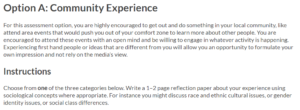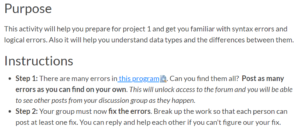Spring is upon us and growth and change is a fitting topic to explore this time of year. Here are four changes we saw in courses that we’d love to share with you, as well as the instructor’s perspective on these changes.
Adding Choice to Invigorate a Boring Assignment
Course: Introduction to Sociology, UW Flexible Option
Old: Students reviewed graphical U.S. census data and compared racial and ethnic populations over time.
New: Students can choose to conduct research on stratification or attend and analyze a community experience through the lens of race and ethnicity, gender, or social class.
Instructor Perspective
Dr. Gregory Peter shared his thoughts on developing the new assessment:
I wanted to change the assignment because it was a simple and somewhat boring graphing assignment about using census data. I was getting tired of grading it, and it didn’t really have a lot of meaning to the students. Laurie [my instructional designer] suggested that we think of something more experiential that the students could relate to. I usually try to get my students to apply Sociological concepts to their own lives or to current events as a way of making it relevant to them but also as a way of realizing how useful Sociology can be in everyday life.
The assignments we created are much closer to that goal and I am really happy with them. Laurie was really the impetus in making the suggestions. I just helped brainstorm ideas on how we might go about it. The nice thing about being a mid-career faculty member is that I finally really know my material and how to deliver it to the students, and that is really satisfying.

Enlivening Discussion Boards through Debate
Course: Introduction to the Study of Religion, UW Flexible Option
Old: Students watch a video related to a religion topic and write a brief reflection.
New: Students watch a video on a religion topic, then debate that topic with each other on the discussion board.
Instructor Perspective
Dr. James Powell reflected on how the discussion was a positive change:
I can see that some of them really enjoy addressing the arguments of other students and/or me (I post pro and con posts also). It is a great positive and something I include in every course I have developed since then.

Practicing for Projects through Group Problem-Solving
Course: Programming I, Applied Computing Program
Old: Students participate in weekly discussions on programming-related topics.
New: Students participate in small group problem-solving scenarios on the discussion board to practice their skills for the programming projects.
Instructor Perspective
Dr. Ahmad Abuhejleh reflected on why he changed the discussions in his course:
After teaching the course for a couple of years, I found out through discussion questions, email, feedback, course evaluation that there are two areas students struggle with: the first exam and course programming projects. To remedy that, we created a discussion with each project where I gave similar code but different problems and asked the students to debug them and find what went wrong. The problems that I injected in these discussions are logically similar to the ones that the students run into while doing their projects.

Creating Connections with Collaborate Ultra
Course: Object-Oriented Programming, Applied Computing
Old: Students asked for help with programming work via email or discussion board.
New: Students meet with the instructor using Collaborate Ultra (web conferencing tool that integrates with Canvas) to get help in real-time with visuals.
Instructor Perspective
Dr. Anthony Varghese shared what a big difference using a web conferencing tool made in reaching his students:
I was able to use Collaborate [Ultra] with a couple of students, and it wasn’t perfect but the screen sharing really helps with debugging students’ programs. I would say it was crucial to helping some students out of the trouble they were having! … Before I used Collaborate, I did not have anything to offer as far as helping online students in an interactive way—we had to exchange many messages back and forth over time. The only other thing is that sometimes a student might feel really isolated and reaching out with just a couple of interactive one-on-one sessions really helps them out.
Little Changes, Big Changes
As you can see, there are so many little and big ways to make a change for the better in a course. From re-designing a course at revision time to changing the method you use to communicate with students, there are so many ideas to try out. We’d love to learn about the changes you’ve made—please comment below and share with us!